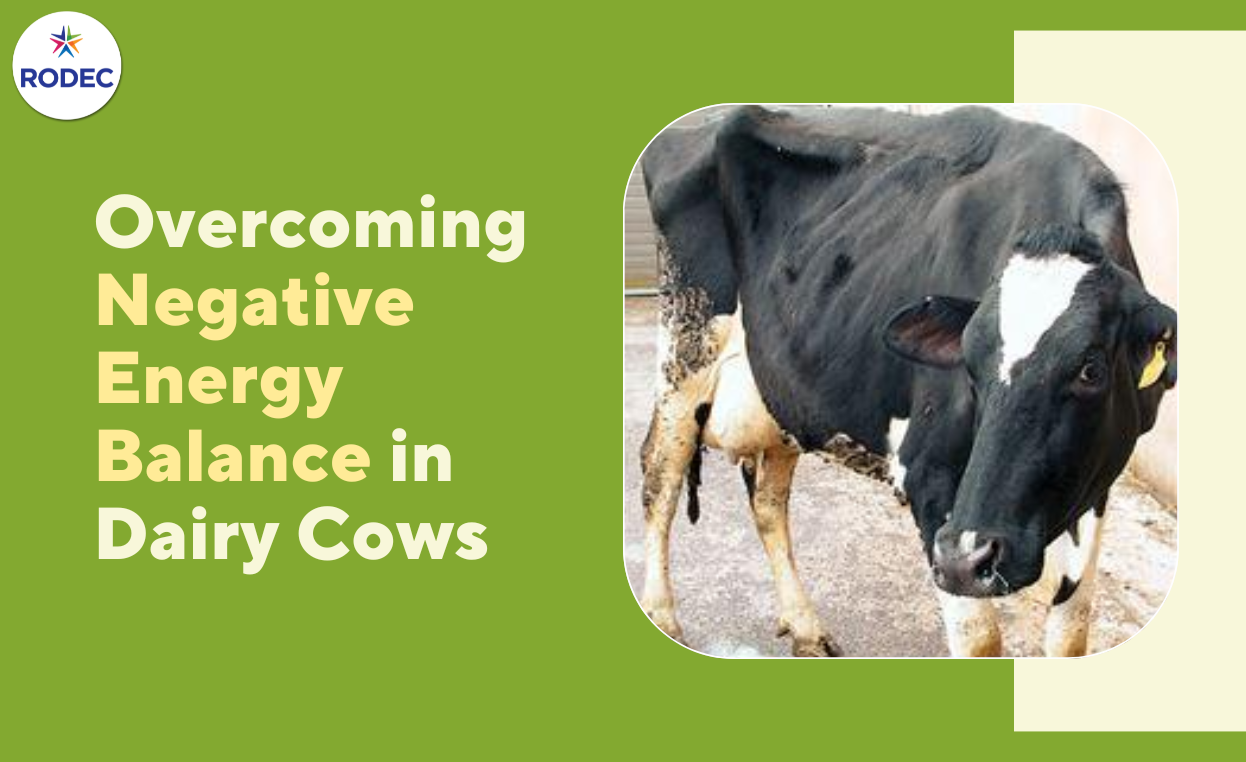
Blog |
August 08, 2024
In dairy farming, maintaining the health and productivity of cows is the most essential. A crucial factor in this equation is energy balance, particularly negative energy balance (NEB), which significantly impacts the well-being and productivity of the dairy cows, especially during early lactation.
What is Negative Energy Balance?
Negative energy balance (NEB) occurs when a dairy cow expends more energy producing milk than it takes in through her diet. This imbalance is particularly experienced in the first few weeks after calving, as the cow transitions from pregnancy to lactation.
Causes of Negative Energy Balance (NEB) in Dairy Cows
Negative Energy Balance commonly occurs in early lactation due to several factors:
- High Milk Production Demand: Immediately after calving, a cow's body undergoes a dramatic shift, rapidly increasing milk production to nourish her calf. This process is highly energy-intensive, placing immense strain on the cow's energy reserves.
- Transition from Dry Period: The animal's metabolism changes significantly between pregnancy (dry period) and lactation. Their bodies must adjust to changing hormonal balances and food requirements, which might disturb energy homeostasis and lead to NEB.
- Changes in Feed Intake: Despite the increased energy requirements, cows frequently consume less feed in the early postpartum period. This could be due to a variety of factors, including digestive issues, discomfort, or changes in feed preferences. The difference between energy expenditure and ingestion increases NEB.
Effects of NEB
Negative Energy Balance (NEB) has significant consequences:
- Milk Production and Quality: Cows with NEB frequently produce less milk than their potential. In addition, the composition of the milk can be changed resulting in lower quantities of fat and protein, affecting both the dairy farm's profitability and the nutritional value of the milk.
- Reproductive Challenges: NEB affects the cow's reproductive function, resulting in a delayed return to estrus (heat cycles). This extended anestrous stage decreases the likelihood of successful breeding and calf conception, affecting population replacement rates and overall production.
- Increased Health Risks: The body's response to NEB is to mobilize fat reserves for energy, which can lead to metabolic problems such as ketosis. Cows with NEB are also more prone to other health issues, such as mastitis and metritis, which endanger their overall well-being and productivity.
Strategies to Reduce Negative Energy Balance (NEB)
Effective management strategies can help reduce the negative impacts of NEB on dairy cows.
- Nutritional Management: Providing a carefully balanced diet with ample energy is crucial. Feeding high-quality forages and concentrates, and potentially supplementing with energy-dense feeds like fats or oils, can help meet the cow's increased energy demands during early lactation.
- Feeding Practices: Regular and consistent feeding schedules are essential to encourage consistent feed intake. Ensuring feed availability and palatability can help prevent reduced feed consumption.
- Monitoring Body Condition Score: Regular monitoring of body condition score allows for early identification of animals at risk of NEB. Implementing feeding strategies to prevent excessive weight loss can help maintain energy reserves and support optimal health and production.
Role of Supplements and Feed Additives
- Proper Supplementation: Supplements like CPE 240 Advance play a crucial role. CPE 240 Advance is a complete and advanced solution for complete recovery from Negative Energy Balance. It is designed to enhance energy intake and support metabolic functions during early lactation.
- Importance of Rumen Health: A healthy rumen, the primary digestive compartment of cows, is essential for efficient feed utilization and energy extraction. Monitoring and maintaining rumen pH and microbial balance are critical.
- Regular Monitoring and Management: Close monitoring during critical periods, such as the transition from dry period to lactation, allows early detection of Negative Energy Balance (NEB) and prompt intervention.
Importance of Addressing Negative Energy Balance
Addressing Negative Energy Balance (NEB) promptly is crucial for optimal cow health and productivity.
- Improved Animal Health: Cows are less prone to develop metabolic diseases such as ketosis and fatty liver if NEB is prevented or minimized. These abnormalities can cause major health problems and even death. Healthy cows are prone to other ailments and have a higher overall well-being.
- Enhanced Productivity: Maintaining an energy balance is necessary for achieving good milk production. NEB can greatly affect milk production and quality. Additionally, resolving NEB rapidly promotes optimal reproductive function by ensuring cows return to estrus and conceive successfully.
In conclusion, Negative Energy Balance (NEB) poses significant challenges to dairy cows, particularly in early lactation. By understanding its causes, effects, and implementing effective management strategies—including nutritional adjustments, and maintaining rumen health—farmers can enhance their dairy animals’ health, productivity, and overall farm profitability. Proactive management of Negative Energy Balance not only benefits individual cows but also ensures sustainable dairy farming practices in the long term.
Related Product: CPE 240 Advance


